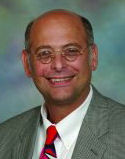In like Flint
The Austin Flint murmur was named for a physician who disliked eponyms.
It was a typical day on the wards. During some bedside physical examination teaching (yes, it still happens), the medical student noticed an unusual finding on auscultation of the heart of an elderly gentleman. The team gathered quickly to give their best effort at determining what was particularly interesting about this man's heart. The intern accurately noted the high-pitched decrescendo diastolic murmur. Great catch, but not the most interesting feature. The consultant had nothing to add.
The senior resident, soon to be a cardiology fellow, still had not had his turn with the stethoscope. After careful auscultation, he muttered something about an Austin Flint murmur under his breath. It was hard to be sure if he had actually heard it, or just logically assumed it was the finding in question, but either way he had nailed it. The rest of the team launched into a discussion about what exactly was an Austin Flint murmur. In no time, you could hear the sound of crickets chirping. (Just kidding—of course, we all know crickets are a Joint Commission violation.) The optimistic medical student in back posited that at least Dr. Austin and Dr. Flint would be happy we remembered them.

Not exactly. First off, there was no Dr. Austin, and Austin Flint is not a hyphenated name. For whatever reason, the eponym bears the murmur discoverer's first and last name. Dr. Flint would not have been very pleased by that, or by the incident described above. In fact, he reportedly wrote that “So long as signs are determined from fancied analogies, and named from these or after the person who describes them, there cannot but be obscurity and confusion” (11. Landis HRM. Austin Flint: his contributions to the art of physical diagnosis and the study of tuberculosis. Bull Johns Hopkins Hosp. 1912;23:182–186.). How ironic that a physician so opposed to eponyms is best remembered for the murmur that contains his surname and given name. What's more, he was treated on his deathbed by Dr. E. G. Janeway, the father of the man for which Janeway lesions were named.
Austin Flint was born 200 years ago in Massachusetts; his father was a prominent physician. In fact, he came from a long line of physicians which continued after him. Perhaps this was the reason why someone unduly punished this hater of eponyms with one of the few first-and-last-name medical terms. Despite being remembered for a heart murmur, Dr. Flint was actually involved with many aspects of medicine. He lived in a time before hyper-specialization, when physicians could dabble in whatever field they found interesting. In the course of a career that included professorships at six medical schools, two of which he founded, Dr. Flint wrote important papers on typhoid fever, diabetes and tuberculosis. He also was thoroughly involved with improving diagnosis by physical examination.
In one of his writings (22. Flint A. On cardiac murmurs. Am J Med Sci. 1862;44:29-54.), Dr. Flint explained the reason for his interest in cardiac murmurs. He was seeing an 11-year-old girl with rheumatic disease when he noted a very loud murmur. He subsequently notified the girl's mother that she had a heart problem that was “likely to destroy life within a period not very remote.” Not only was this an unnecessarily sinister description, it was also wrong. The girl was still alive at the time of his writing that paper, 13 years later. Several similar episodes led him to see the need for better description of heart murmurs and their significance.
In the same paper, Dr. Flint first described a “pre-systolic blubbering murmur” that occurred in a patient with aortic regurgitation. At the time of auscultation he assumed the murmur to be related to a stenosis of the mitral valve. How did he eventually find out it wasn't, you ask? Being a good scientist of his day, he waited until his patient died, and examined the offending valve during autopsy. To his surprise, there was nothing abnormal about the mitral valve.
He postulated that the extra murmur was due to the aortic regurgitation—that the rapid filling of the left ventricle caused the mitral valve leaflets to float back together. While the murmur was undoubtedly related to that, his further description of the mechanism is probably incorrect. We say “probably” because even with modern echocardiography and cardiac MRI, there is still controversy surrounding what actually causes the murmur. Papers published as recently as 2008 explain that it seems pretty sure it is due to the regurgitant jet hitting the anterior mitral valve leaflet rather than the distention of the ventricle. You can't really blame a man with only a stethoscope and scalpel for not getting this exactly right.
Dr. Flint died in 1886 after a long career that earned him the deserving title of “the American René Laënnec.” Amongst other achievements, he made a valid point about eponyms. Modern medicine is slowly doing away with them, although his may stick. The “Austin Flint murmur” sounds a lot cooler than “that weird diastolic murmur that sounds like mitral stenosis but is really due to aortic regurgitation.”



